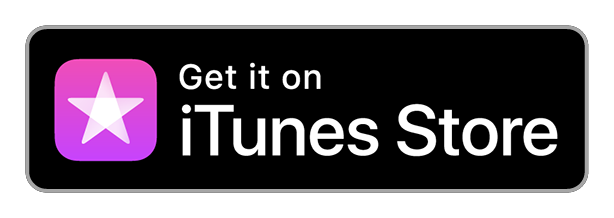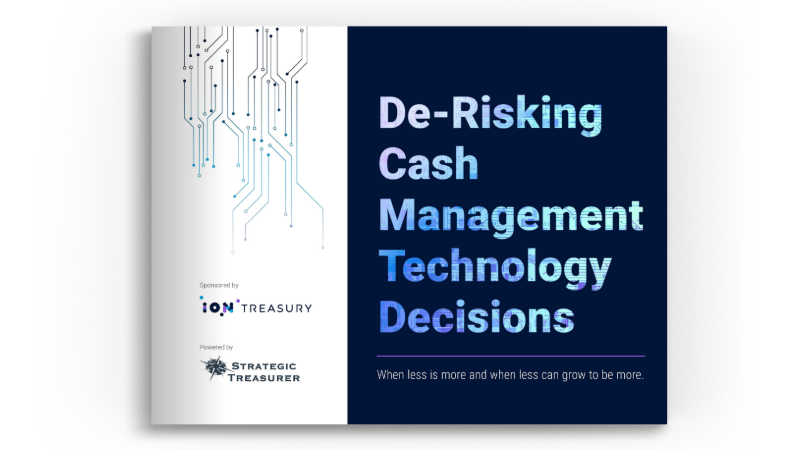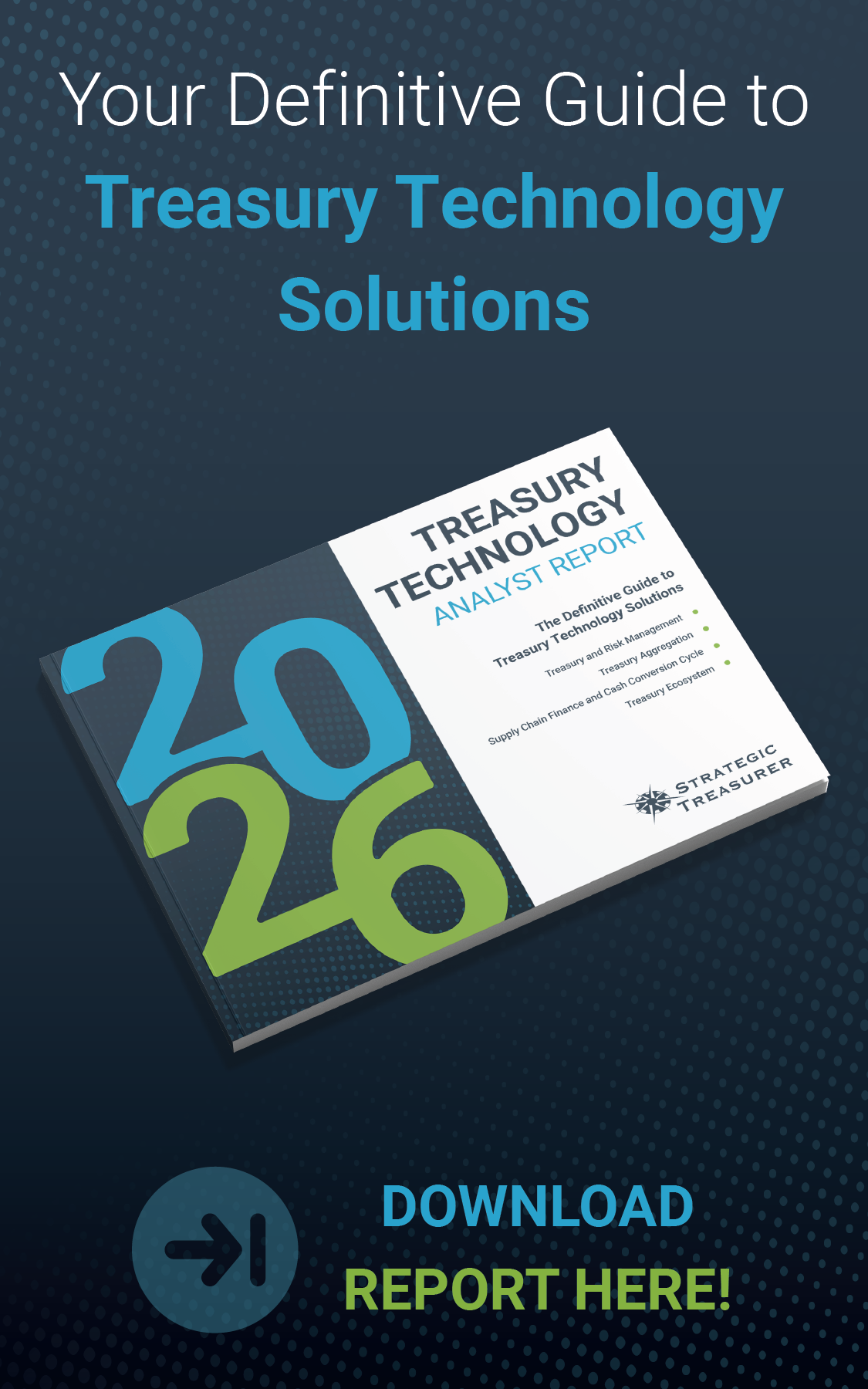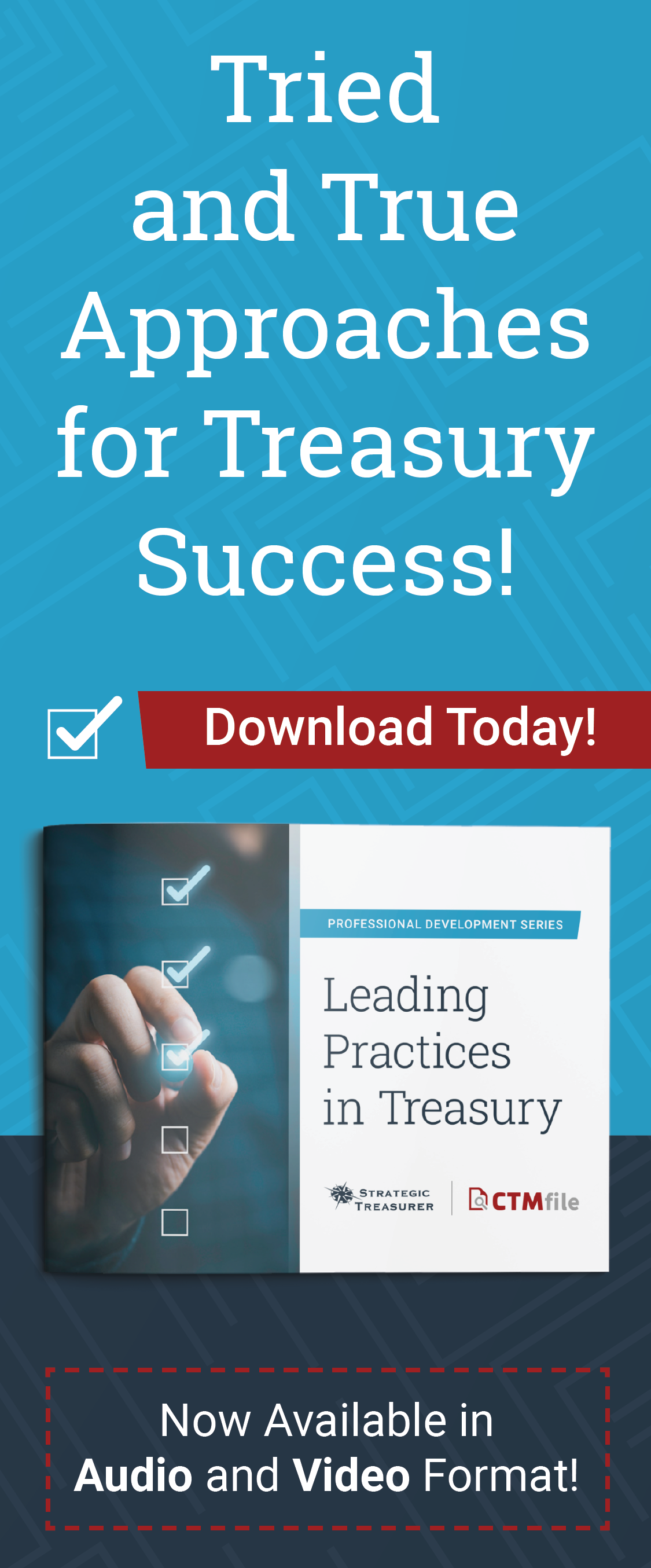
Episode 320
Exploring the Efficient Frontier: Cash Investment Strategies
In this episode, Craig Jeffery and Paul Galloway discuss the “efficient frontier.” They explore risks, rewards, and trade-offs between options like money market funds, ECR, and IDA/ICA. They also talk about liquidity needs and capital access. Listen in to learn more.
Host:
Craig Jeffery, Strategic Treasurer
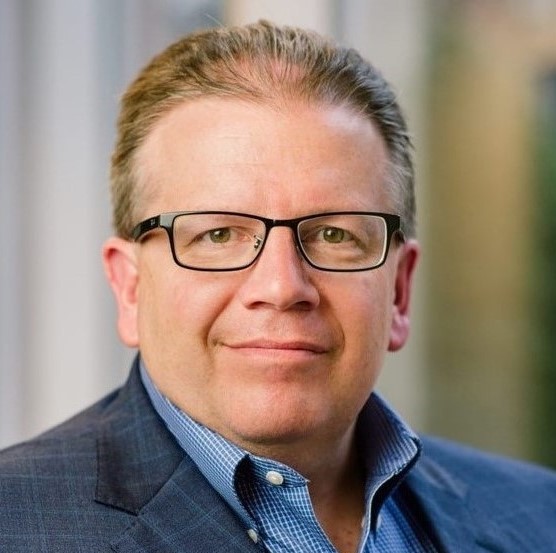

Speaker:
Paul Galloway, Strategic Treasurer


Subscribe to the Treasury Update Podcast on your favorite app!
Episode Transcription - Episode # 320: Exploring the Efficient Frontier: Cash Investment Strategies
Welcome to the Treasury Update Podcast presented by Strategic Treasurer. Your source for interesting treasury news, analysis, and insights in your car, at the gym, or wherever you decide to tune in.
Craig Jeffery 00:19
Welcome to the Treasury Update Podcast. I’m Craig Jeffery. I’m your host today for this episode on the efficient frontier, from the general concept to a discussion on some cash instruments. I’m joined by my colleague, Paul Galloway. Paul, it’s good to be back on the treasurer update podcast with you. It’s been a while.
Paul Galloway 00:39
It has been a while, it’s it’s good to be back. And great discussion topic. I definitely like the efficient frontier.
Craig Jeffery 00:46
Yeah. So for those who remember, the investment class is about the efficient frontier, maybe you could give us that quick overview of the efficient frontier. What that means for investors. How do we how do we think about what is the frontier?
Paul Galloway 01:01
Yeah, this concept’s been around for quite a while. Harry Markowitz came up with it in the early 50s. And what it is, is it’s a way to think about risk and return profiles of investments. And you can think about creating a portfolio of investments that may be from 100% bonds, let’s say 100% treasuries, US Treasuries, all the way to pure equities. Maybe we’ll just say US domestic stocks today, and you can create portfolios that have mixes of those types of investments, and each one of those investments have characteristics of risk, risk in the form of standard deviation. If you were to graph this out, you have a vertical access that’s return. You have a horizontal access that’s standard deviation or risk. And you plot these portfolios out, you end up with this, this curve. In this curve, it starts out, you know, with a lower return, perhaps a little bit higher standard deviation, and starts going up into the left. You get less standard deviation, higher return, and then it starts reverting the other way. So this curve goes up and that goes back out to the right along there. What the efficient part is, it is you would select a portfolio where it’s tangent on that curve to the highest return for the least amount of risk, and that’s what the efficiency is. But there’s trade offs associated with doing that. Sometimes you may be willing to take on more risk to get more return. So while that particular point may be the most efficient, it may not be the portfolio that you’re willing to select. You may be willing to select more risk because you want to get more return. You may be more risk adverse, and so you may select a portfolio that has lower standard deviation or risk and accept the lower return, but the concept is still the same. You have trade offs of risk and return risk and reward. These portfolios, they change over time. It’s not set it and forget about it. So you would reallocate your portfolio based on your risk reward profile, whatever that might be.
Craig Jeffery 03:29
Yeah, excellent. Thanks for going through the concept and that that leading edge that exists on the risk reward or trade off concept, and you know your point about essentially being efficient with this over time, because these things change, and how do you maintain what’s the frontier? If the frontier shifting, how do you keep doing that? But I wanted to shift to, let’s just call it, practical matters, right? The theory is one thing, but if we talk about cash investments, how should we think about the efficient frontier and cash investments are shorter term cash, everything from leaving balances in the bank account to hard interest earned on accounts, ECR, institutional money market funds, IDA or ICA bank deposits that are insured and split out among banks, commercial paper, short term bond funds. How would you recommend a company think about some of these different cash investments in light of the risk, reward or efficient frontier?
Paul Galloway 04:30
Yeah, I think there’s a couple things to keep in mind. One, does your organization have a short term investment policy in place that sets the guidelines for what you can invest in and how much you can invest in those various categories? So that’s first thing you gotta know as a treasurer. Okay, what can I do? So once you know what you can do, then it’s a matter of understanding what I think my liquidity demands are gonna be, my cash flows and the trade offs associated with either having cash at a bank and getting an earnings credit rate or investing in different types of investments, whether it’s money market, mutual funds, IDA, commercial paper, short term bonds, any of those types of investments. You’ve got trade offs associated with parking money at the bank or parking money in these different investment vehicles. As a treasurer, one I’m trying to get the most bang for my buck. I want to make sure that I have my cash working for me. So I’m going to try to make sure that I can put as much to work, to make sure that I generate a cash return on those particular items. When I think about money market funds, there’s a variety of bonding market funds are out there for institutional investors. A lot of people think of the 2a-7 funds you could invest in, treasury or government funds which are less risky. They do provide less risk, a little bit lower return. A lot of institutional investors will invest in prime funds, which they take on a little bit more risk, so you can generate more yield on your cash with those those particular items. Now, if you’re a little less risk averse, certainly look at Treasury or govy funds. But another option for you would be the IDA or ICA accounts, which these are insured deposits. And so what these fund companies will do, or various institutional investors have the ability to do, is essentially buy into a pool of federally insured commercial paper or certificates of deposit. Think of it this way. They have a portfolio of banks that they have relationships for. They can go out and take $250,000 the FDIC limit, invest $250,000 with that bank and get you a nice bank rate on those CDs. They’ll go out and they’ll search for the highest yields that they can. Those will be fully insured. So while there could be fluctuations tied to a particular bank, if there is a problem with a bank, you have FDI insurance to cover any particular losses. So 250 in that bank, 250 in another bank. So you have this portfolio of these CDs that they’ve gone out and made these investments on your behalf of. One thing to think about, there is a limit to how much you can invest in there before there might be a drop down in the return that you get with these particular type of types of investments, but you can make very sizable investments that have FDIC insurance on them. So it’s a really nice investment for treasurers to put into their toolbox. Plus liquidity is pretty decent as well. They give you enough liquidity that you can get your funds. Commercial paper will lock you up longer. It may give you decent rates, but you gotta go out. You gotta search it. You gotta go. It takes time to go and do commercial paper investments, and you have to be on it first thing in the morning, or you’ll lose out on those particular investments. And it does lock you up for a period of time. Short term bond funds, these would be, you know, maybe similar to your prime funds, they’re going out and investing in pools of short term bonds. They have a variety of credit risk associated with it, and particular returns that could be a little more appealing for longer term investments. So when I think about this, I think about, you know, bank balances, ECR, I want to maximize that to the extent I can maintain balances that are acceptable for liquidity, daily liquidity, demand needs, but I want to backfill that with investments in a separate account, which we didn’t really touch on that too much, but you could have a separate account where you have a pool of investments in your money market funds, your IDA, your commercial paper, short term bond funds, so you have kind of a strung out portfolio that gives you different risk return profiles and also liquidity profiles as well. So understanding what you can accept and what you can’t, I think, is important when you think about these various types of investments.
Craig Jeffery 09:29
When you talked about IDA and ICA and then you added in brokered CD deposits, I hadn’t even thought about that side versus an IDA or an ICA at the insured deposit account, where you usually have daily liquidity, oftentimes next day, sometimes two days, depending on the structure, different from a CD type arrangement. So, yeah, excellent. Thanks for going through those.
Paul Galloway 09:53
Yeah, you know, create when we think about ECR versus IDA, ICA and. In money market funds. How do you think about the return, risk, return differentiation? What would make you invest in one versus the other? So let’s take like ECR versus IDA and ICA. You know, is there a certain point at point at which you would make an investment in one versus the other? What might that look like to change your decision?
Craig Jeffery 10:26
Yeah, that’s good. So if you look at earnings, credit rate at a bank versus insured deposit account, couple things. One is it’s going to be almost impossible to get an ECR that’s as competitive and that’s competitive with an IDA, if you could get the same rate, I would probably leave it for ECR. All things being equal, because there’s an element of the your operational activity where, why would you move money out of your main account if you’re earning the same rate? And but there’s other couple qualifications. There’s will that earnings credit rate apply to, you know, all of my fees, or will it provide a surplus so I’m not really getting that benefit? I hate to say that there’s so many what ifs on that, but generally, leaving money in your core bank is going to be a little bit easier for that. But same rate, I would be concerned about counterparty risk with, you know, how much I might have at that one bank if I’ve got, you know, 15 million, well, I’m exposed 14,750,000 seems like it’d be better to get, you know, move some off and have full insurance coverage. To get the same or a higher rate with with lower risk, within 15 basis points, same type of thing, greater than 50 basis points, you’re probably going to leverage either one you’re assuming your bank is pretty safe, and as long as you’re within your level of counterparty risk exposure, you’re willing to take above what’s insured, that would be the case, but most, most times above a certain level, I would go with an IDA and ICA if it’s anywhere close to the same rate. What about hard interest? Right? Some banks can pay hard interest, same type of question, more related to the risk level. So anything close shunting off that risk, I would favor an IDA or an ICA over hard interest, above whatever the initial level that you needed for operational income, but once it’s got somewhere past 25 basis points, certainly past 50 basis points, interest rate differential, the spread differential with you know, would largely move you to the higher yielding account. That would be my take on that, Paul.
Paul Galloway 12:35
Well, certainly IDA, ICA allows you to manage that concentration risk across many banks versus a handful of banks. Those are really good points. But you think about money market, mutual funds versus ECR, what would be the differentiator there?
Craig Jeffery 12:55
It would be similar to the other, you know, the other example of ECR versus an idea with the example, that you don’t have the same type of coverage with the money market. You have exposure to individual holdings, that there could be a loss, because money market funds can lose, can lose value. There’s not the same type of insurance that the FDIC would offer, for example, and so you have more concentration risk on the ECR side versus you have some diversification on money market side. So the the concentration risk is more on the ECR for larger amounts, because you’re at one bank. So same rate. I’d go with money market funds. Same thing. Money markets are almost always going to pay more than an ECR, but it’s going to be money markets for for me, for most company situations.
Paul Galloway 13:48
Yeah, that really makes sense. Craig, how would you view it? Or would you view it differently when we compare money market mutual funds to IDA, ICA?
Craig Jeffery 13:58
that gets a little little trickier. So you’ve got a couple elements there. You’ve got the how quickly can you get your cash? Is it one day delay, two day delay, same day. So there’s an element of liquidity. When it’s the same rate. You have diversification with both, but you have Bank Guaranteed and FDIC insured. You got two levels of coverage, and they can’t lose value, you know, an IDA or an ICA most of the structures are you can’t lose value on those, whereas money market, there’s the potential. But it’s pretty rare where that happens. So it’s not, this is not a common event. It’s not happening every, you know, a year, every six months. You know, we have to go back a ways before we saw that happen. Yet, it’s not nothing. So the same rate would certainly favor from a diversification risk standpoint, if we isolate to that the IDA or ICA, and today, as we’re looking at things that the day we’re recording, that the difference is probably 9 to 13 basis points between those two. So within 15 basis points, you know, there’s the whole I have better coverage. The difference is is very tiny for higher level of coverage. So my level of risk adversity would be the IDA or ICA is better for within 15 basis points. When you get to 25 basis points, I know a lot of companies that would be, hey, we’re going to go, you know, let’s say money market fund would be higher open, higher risk, but it’s very minor risk in normal, safe times, that would definitely move, move me and others to a money market fund. Most, most people, right? It’s a safe, stable time. The more there’s churn, the more there’s concern. That’s that you’d pull back a little bit there. You get over 50 basis points, it’s going to be hard to convince companies that don’t have other drivers on diversification or requirements for that to not choose a money market on there. So trying to give some guidance there, as opposed to just the general theory, each company needs to make their decision on overall risk, access to capital, other factors and the difference in this and the yield they may get given some different risk profiles.
Paul Galloway 16:09
I think that’s a good segue into these other factors. You kind of touched on it, access to capital. Treasurers and companies got to think about, do they have access to capital? Who do they have access to capital from? And what form does that come in? And so capital comes into an organization in different forms. It could be, hey, it’s coming in based on general business and the growth of the business, but you may need additional capital to fund company needs. It could be growth of the organization organically or through acquisition. It could be return of capital to investors. It could be some combination of those. When you think about access to capital, either in fixed form or in contingent form. You know, what are some of the factors you think of with access to capital, Craig? I like to think about what the needs are, and then I’m managing that to some level of weighted average cost of capital to help generate a greater return to investors within my company, and so I have tend to have a focus on needs and costs to drive value.
Craig Jeffery 17:32
That certainly makes sense. You know, the first thing that popped in my mind when you said that, though, was the relationship issue, right? I’m a company. Maybe I need long term, term bonds, maybe I’m borrowing a short term basis or not, but I want to be important to certain banks in my that are part of my relationship. How do I remain important to them? Is making sure that they get the type of return that’s necessary. So we’re important to them just like they’re important to us. So some of that’s going to have some influence, right? I want to make sure my key partners are rewarded. You know, the secondary would be the investment element. So foundational core access to capital is, is essential. And, you know, would influence things at least, at least at some level. You talk about portfolios, I usually use terms like, how do you stratify this or that? It’s the same thing. How do you you know, if you have to make some alternatives or bring some things together? To say, maybe I use several different instruments for investments, and I’m doing this for my operational needs. I’m doing this to support my relationships. I’m doing this other financial instrument to support liquidity or diversification or safety of principle, and so some of those things go together with that whole portfolio approach that you talked about, you know, as we diversify and stratify what we do.
Paul Galloway 18:55
Yeah, I think that’s great points. And, you know, just kind of going back to the comments you made about money market funds versus IDA ICA. You talked about liquidity. You think about daily liquidity needs. What that might be? Maybe it’s same day, next day, two days from now. How that impacts how you might make investments between you know, those two options are money market funds, IDA ICA, liquidity has to be really taken into consideration, because if I’m investing in Treasury and govy funds, I can get that same day. But if I’m investing in prime funds, IDA ICA, it’s one day or two days later before I can get my cash. So trying to manage liquidity. Need to understand what the needs are. I think about Cash Forecasting, I have clear visibility to what’s going to happen between now and the next five days relative to the investments that I have cash tied up in. It’s bank, its money market funds, its IDA, ICA, maybe its commercial paper, short term bonds or separate account, like we talked about earlier, managing the daily liquidity can be challenging. So how, how do you think about the cost of managing your daily liquidity portfolio versus the needs and demands in return on cash?
Craig Jeffery 20:32
I was hoping it wouldn’t bring in those complicating factors, right? It’s now you’ve got the cost of managing the amount of time that’s necessary. Maybe I’ll answer it this way. So, you know, as we, as we advise companies across all treasurer areas, those are done on a specific, individual basis of what recommendations are. So I think everybody listening needs to understand we’re just talking some generalized terms that would need to be calibrated for your, for your, your company’s organization. But let’s, let’s say you had, you had a good forecast. You were pretty accurate, but sometimes you might see a swing of one to two or $3 million a day. But maybe, generally you you tend to have 20, 25 million. Maybe you have these funds at a core bank that you do business with. And let’s say you earn hard interest. Well, you may keep, may keep a couple million in that in that account, you’re earning hard interest the bank enjoys having the balances, and that fits with your your goals, on your share of wallet and and keeping them happy. Let’s just say that that 2 million is there. They want more. But that may be some good fit. For example, you may want another 2, 3, 4, 5 million in a money market account. That’s short term that you can get same day, always same day, even up to, you know, maybe a four o’clock deadline. So maybe keep three in the bank for hard interest, five in the, you know, money market to cover your larger, larger surprises, and then maybe the rest you’re putting there for diverse location reasons. So if we’re talking 20, so maybe that’s you put 12 in an IDA. In that case, another situation, maybe you have more volatility. You don’t have as good of a forecast, and you need more access to it. You might have a lot more in your money market fund, and maybe more in your in your bank, or in hard interest. The IDA, ICA may be smaller, and that’s just us talking about those three potential options. But, but as you look and you say, what our needs, how well can we forecast? What’s our elements of risk? Now you can say you put together, you know, 1, 2, 3, 4, 4, things to manage the short term aspects. And I think the other thing Paul that we didn’t talk about is some of these instruments, and some of these, you know, is the bank really favorable and paying for balances right now? That’s definitely the case. A few years ago, it wasn’t the case. They’re like, to a lot of customers, like, we don’t need your balances. They’re not good. There’s elements that change. You know, what a bank may be willing to pay, what banks are willing to pay through these, IDA, ICA, what Commercial paper is doing, money, market, funds, all these have different characteristics in different markets. So, yeah, I’m mindful of what you said in the beginning. It’s, you know, the efficient frontier changes over time. Same thing, even as we’re talking about cash items, these things change over time. And I know we talked a lot of people are really smart on the short term cash side, it’s, it’s so interesting to see how often this changes.
Paul Galloway 23:35
Yeah, no kidding. I mean, that’s, that’s the dynamics of everything we talked about, it’s it’s constantly evolving. It’s changing. And we had really boring short term investments for a long time leading into COVID. COVID hit, things changed. People panic. Risk increased quite a bit. Return increased quite a bit. All of a sudden you’re able to be able to think about where you were going to get returned. And then all of a sudden everything collapsed, and your prime funds were earning nearly as much as a little bit more than your treasury and government funds. And so now earning a return on cash, it just wasn’t there. Risk was super high, but you couldn’t get any return. So things, you know, just constantly change, but sometimes can change very abruptly. COVID changed things quite quickly, and all of a sudden, managing cash became much more difficult in terms of having liquidity and having some type of return, because you just weren’t able to find it. Before, this whole portfolio returned out there, COVID hits, totally changed it.
Craig Jeffery 24:49
You know, when interest rates were, you were pushed down to the floor recently, people canceled sweep accounts, right? Sweep to some type of investment. Because why would you pay several $100 a month, or whatever the particular amount was to sweep to investment, if you’re earning two basis points total, like those got shut off. And so when rates came up, companies started flicking those back on, because now it was worth the cost, as you had talked about, Paul, any any final thoughts on the efficient frontier and our hopefully a practical discussion on that?
Paul Galloway 25:16
I can see that we’re probably going to have some more changes in terms of what those portfolios look like as I think the Fed is going to start dropping interest rates here relatively soon. More changes, more considerations as a treasurer, lots of lots of interesting aspects to consider, liquidity, risk, reward. It’s constantly evolving. As a treasurer, you kind of stay on top of these things.
Announcer 25:55
You’ve reached the end of another episode of the Treasury Update Podcast. Be sure to follow Strategic Treasurer on LinkedIn, just search for Strategic Treasurer. This podcast is provided for informational purposes only, and statements made by Strategic Treasurer LLC on this podcast are not intended as legal, business, consulting, or tax advice. For more information, visit and bookmark StrategicTreasurer.com.


